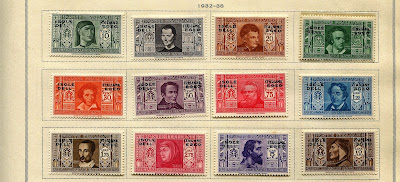Italian Postmen in
Uniform, ca 1861
Bud's Big BlueBud's Observations
The main problem with filling BB’s Italy spaces: Italian
stamp dealers try to corner the market on the few stamps that are not readily
available in feeder albums, then ask a fortune for them. Catalogs too often
reflect these ridiculous mark-ups. So, the world-wide collector either waits
for reasonably priced examples to come along (and they do, occasionally), or
lives with permanent blank spaces.
I waited.
Well, I mostly waited, but I did capitulate in a few
instances, such as the Italian zeps with tabs and the Aegean zeps. The price
for these could have paid for a small Italian car (used, of course). They
didn’t make the cut for BB pages proper, though, so they’re found in the
supplement pages. Sigh.
Enough ranting!
If I were to select a single country’s stamps as a tool for
studying the sweep of Western European history, both ancient and modern, Italy
would be the obvious best choice. It seems almost as if Italian stamp designers
intended to educate, if not propagandize, the postage-using public. Before and
even during the Fascist era this tendency surfaces, but it reaches fruition
post WWII. Add a few early Italian stampless covers (which trace back as far as
the 14th century in Lombardy) and you’ve got something more enlightening than a
college textbook.
Census: 617 in BB spaces, 15 tip-ins, 465 on supplement
pages many of which have Aegean Islands overprints. The Aegeans had a separate
section in BB’s earlier editions.
Jim's Observations
For the 1962-1925 period, there are 171 major number stamps. Of the 171 stamps, 106 (62%) are CV <$10. The stamps of Italy are expensive, but not as expensive as Great Britain or France for the era. They are also classical attractive, as one would expect from artisan rich Italy.
I really enjoyed putting the classical issues of Italy into Deep Blue. And ,with few exceptions, they are not difficult to identify either.
The Scott Classic Specialized catalogue has, from 1926 ( and beginning with Scott 178) to 1939, 224 major numbers. Contrary to the earlier issues, commemoratives far outnumber definitives.
They can be divided into three categories...
• Saints and scenes of the Holy Catholic Church. Mussolini, with his anti-Communist opposition, convinced many Catholics to actively support him. Still, it is jarring to see an issue devoted to St. Anthony, while the next issue is glorifying fascistic expansionism.
• Issues devoted to scientists (Volta, Galvani, Marconi), literature (Dante, Horace), music (Stradivarius, Bellini) and athletic games (University games, Soccer Championship). In other words, the usual subject fare for most countries. But by glorifying the Italian past accomplishments with the present government, it lent legitimacy to the fascists.
• "Propaganda" stamps- either covert or overt. We will see indeed how well the stamp medium works to convey the emotionalism of the fascist movement.
The Italian Offices Abroad and Aegean Islands categories have 844 major descriptions, and tend to be fairly expensive ($1+- $10). That is a lot of stamps. The WW classical collector might not have that many examples, unless a special interest is developed. I certainly could use more.
Italy Blog Posts and BB Checklists
http://bigblue1840-1940.blogspot.com/2013/02/ClassicalItaly1862-1925Stamps.html
http://bigblue1840-1940.blogspot.com/2013/02/italy-1926-1940-stamps-and-propaganda.html
http://bigblue1840-1940.blogspot.com/2013/03/italy-special-delivery-postage-due.html
Page 1
1a
1b
1c
1d
Page 2
2a
2b
2c
2d
Page 3
3a
3b
3c
3d
3e
Page 4
4a
4b
4c
Page 5
5a
5b
5c
5d
Page 6
6a
6b
6c
6d
Page 7
7a
7b
7c
7d
Page 8
8a
8b
8c
8d
Page 9
9a
9b
9c
Page 10
10a
10b
10c
Page 11
11a
11b
11c
Page 12
12a
Pqge 13
13a
13b
13c
13d
Page 14
14a
14b
14c
Page 15
15a
15b
15c
Page 16
16a
Page 17
17a
17b
17c
Page 18
18a
18b
18c
Page 19
19a
19b
19c
Page 20
20a
20b
20c
Page 21
21a
21b
21c
Page 22
22a
22b
Page 23
23a
23b
23c
Supplements
Page 1
Page 2
Page 3
Page 4
Page 5
Page 6
Page 7
Page 8
Page 9
Page 10
Page 11
Page 12
Page 13
Page 14
Page 15
Page 16
Page 17
Page 18
Comments appreciated!



















































































































No comments:
Post a Comment